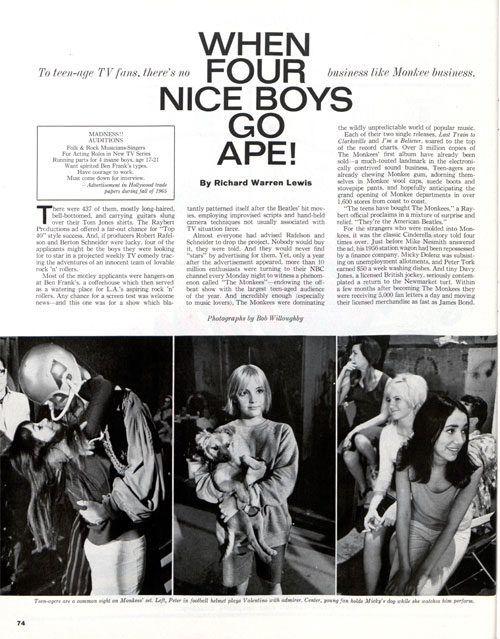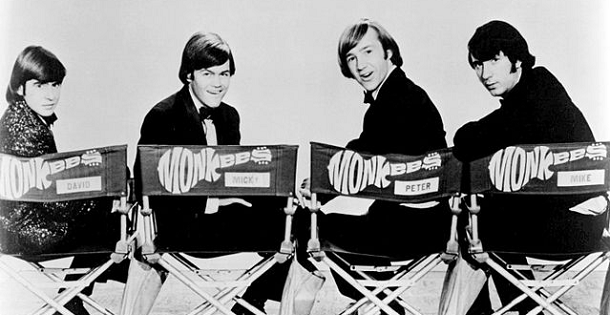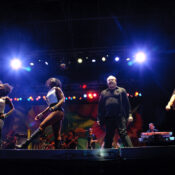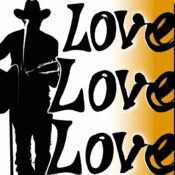“Want spirited Ben Frank’s types,” claimed an ad put into Hollywood trade papers by two television producers in the fall of 1965. The producers were Berton Schneider and Robert Rafelson, and they were referring to a coffeehouse on Sunset Boulevard that attracted musicians and other long-haired crazies from the nearby music venues, Whisky a Go Go and The Trip.
Schneider and Rafelson were out to make a sitcom that could ride the coattails of the Beatles’ stardom, and — after rigorous auditions with hundreds of hopefuls — they wound up with four guys who would comprise a fictional pop sensation. In time, The Monkees would transcend the contrived identities of their characters, but the original goal was good television.
The only Monkee who didn’t have to audition was Davy Jones. He had starred in Oliver! on West End and on Broadway, and his Tony-nominated performance was featured on the Ed Sullivan Show the same night as The Beatles’ first, iconic appearance. Other than Jones, the producers’ intention was to stock the show with no-names. “I would rather work with amateur actors,” Rafelson had said. “If you hired professionals you wouldn’t get the primitiveness we were looking for.”
Despite its obvious nods to the Fab Four, The Monkees pioneered a television style for American audiences. The improvisation, jump cuts, and self-referential nature of the show put an absurdist spin on avant garde cinema styles of the time.
Fifty years ago, The Saturday Evening Post’s 1967 article, “When Four Nice Boys Go Ape!,” gives Bert Schneider’s original pitch for the show: “Hollywood has a thing for making pictures that talk down to young people… We want to do a series in the New Wave style. A very far out show.” French New Wave cinema was popular in artsy circles in the late 1950s and early ’60s — characterized by sometimes plotless expressions of jazz and passion in Paris.

In a particularly free-spirited second-season episode, “Monkees in Paris,” the boys romp around the City of Light being chased by Parisian models before, in turn, chasing those same models and, finally, kissing them and picking flowers. It’s a jolly, albeit senseless, chapter containing sparse dialogue and inadequate gags, but the episode showed the bandmates in uninhibited form. Though The Monkees never made it into the Cahiers du Cinéma, the blend of wacky comedy and unconventional film techniques was a refreshing oddity in the television landscape of family sitcoms and westerns.
The Monkees only lasted two seasons despite winning a couple of Emmys. Still, the show was a goldmine when it came to merchandise. As Columbia television executive Jackie Cooper said in 1967, “The Monkees are not only in show business, they’re in the advertising business.” The fictional Monkees’ pad may have sported a groovy sign proclaiming “MONEY IS THE ROOT OF ALL EVIL,” but anti-consumerism was the real act. Monkee gum and Monkee dolls— even a green wool cap that cost 48 cents more than Michael Nesmith paid for his original — were marketed to adoring fans.
If they started as television actors, The Monkees were quickly transformed into a viable touring band. Before their tour in December 1966, their first album, The Monkees, was a huge success, spending 13 weeks on the number one Billboard spot. They actually sold more records than the Beatles and the Rolling Stones combined in 1967. But the band members began to vocalize their discomfort with the charade. Michael Nesmith told The Saturday Evening Post, “The music had nothing to do with us… It was totally dishonest. Do you know how debilitating it is to sit up and have to duplicate somebody else’s records? That’s really what we were doing.”
Though Davy Jones, Michael Nesmith, Peter Tork, and Micky Dolenz had contributed to the album, the songwriting and instrumentation was largely carried out by seasoned professionals. Their second album, More of the Monkees, was produced in the same way, leading to discontent between band members and Donald Kirshner, “The Man with the Golden Ear” hired from the start by Schneider and Rafelson to produce The Monkees’ tunes. Kirshner used songwriters and musicians he knew, like Carole King, Neil Diamond, Neil Sedaka, and Glen Campbell to create The Monkees’ sound. The bad press the band received from their supposed inauthenticity furthered the divide until Kirshner was ousted from the process in November 1967.
Left to their own devices, The Monkees continued churning out hit records and singles. What started as a fictitious, struggling band had transformed into a breathing, hit-making machine. Michael Nesmith was, perhaps, the greatest advocate for Monkee-autonomy in the music process. He had faith in the group’s creative ability, despite its affected beginnings: “Tell the world that we’re synthetic because, damn it, we are… Tell the world we don’t record our own music. But that’s us they see on television. The show is really part of us. They’re not seeing something invalid.” In 1968’s The Birds, the Bees & the Monkees, the group made an eclectic psychedelic, pop, and folk album headed by the song “Dream World” with lyrics (by Davy Jones) that could whimsically narrate The Monkees’ artistic maturation: “Why don’t you come out of your dream world/ It’s not real/ It’s not the way it seems to be/ Why don’t you come into the real world/ Come with me/ We’ll share our thoughts, forget the dreams/ You’ll see.”
Become a Saturday Evening Post member and enjoy unlimited access. Subscribe now




Comments
THEY ARE GREAT! I grew up with them excitedly as a 12 year old.
A fascinating, insider’s look at one of the biggest and best music phenomenons from the 20th century’s peak decade, that cast a long shadow over the 1970s and ’80s, and has completely obliterated the ’90s-present/future.
The Monkees morphed from being a ‘fake American TV version’ of the the Beatles to a respectable powerhouse group in their own right. They were smart, teachable, coachable and had the connections to the brilliance of Carole King, Neil Diamond, Boyce & Hart and others through Don Kirshner. They helped the American Fab 4 get the kite up in the air, but the Monkees themselves kept it up there!
Personally, my friends and I were delighted between ’66-’68 (ages 9-11) to have the Monkees on each week, and the Soaring ’60s ONLY version of Batman on twice-a-week. The Monkees TV show combined cutting-edge effects editing and style with early 20th century silent films and vaudeville, and the fusion was fantastic.
I don’t know if there would have been a Rowan & Martin’s Laugh-In on NBC without the Monkees having been successful first. The shows were nothing alike and very much alike at the same time in their uses of the above.
The term ‘boy band’ you use on the carousel is REALLY cringe-worthy Nicholas.
It’s only appropriate for ’90s-present “male” groups that sing in the cry baby, exaggerated, elongation-of-every-vowel, gospel style that is the ONLY style the recording industry will allow and accept. It’s been that way the last 20+ years, and most likely stay that way from here on out: 2067, 2107…
Anyhow, here’s what I would said instead, simply changing one word: ‘How the fictional sixties TV band evolved into a musical tour de force.’
Astounding and frankly shocking how changing one word can restore accuracy and respect at the same time for the subject at hand.